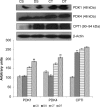Preconditioning with ethyl 3,4-dihydroxybenzoate augments aerobic respiration in rat skeletal muscle
- PMID: 27800513
- PMCID: PMC5085279
- DOI: 10.2147/HP.S102943
Preconditioning with ethyl 3,4-dihydroxybenzoate augments aerobic respiration in rat skeletal muscle
Abstract
Muscle respiratory capacity decides the amount of exertion one's skeletal muscle can undergo, and endurance exercise is believed to increase it. There are also certain preconditioning methods by which muscle respiratory and exercise performance can be enhanced. In this study, preconditioning with ethyl 3,4-dihydroxybenzoate (EDHB), a prolyl hydroxylase domain enzyme inhibitor, has been investigated to determine its effect on aerobic metabolism and bioenergetics in skeletal muscle, thus facilitating boost in physical performance in a rat model. We observed that EDHB supplementation increases aerobic metabolism via upregulation of HIF-mediated GLUT1 and GLUT4, thus enhancing glucose uptake in muscles. There was also a twofold rise in the activity of enzymes of tricarboxylic acid (TCA) cycle and glycolysis, ie, hexokinase and phosphofructokinase. There was an increase in citrate synthase and succinate dehydrogenase activity, resulting in the rise in the levels of ATP due to enhanced Krebs cycle activity as substantiated by enhanced acetyl-CoA levels in EDHB-treated rats as compared to control group. Increased lactate dehydrogenase activity, reduced expression of monocarboxylate transporter 1, and increase in monocarboxylate transporter 4 suggest transport of lactate from muscle to blood. There was a concomitant decrease in plasma lactate, which might be due to enhanced transport of lactate from blood to the liver. This was further supported by the rise in liver pyruvate levels and liver glycogen levels in EDHB-supplemented rats as compared to control rats. These results suggest that EDHB supplementation leads to improved physical performance due to the escalation of aerobic respiration quotient, ie, enhanced muscle respiratory capacity.
Keywords: cellular metabolism; ethyl 3,4-dihydroxybenzoate; exercise; prolyl hydroxylase enzyme.
Conflict of interest statement
Ms Charu Nimker and Mr Deependra Pratap Singh are recipients of Senior Research fellowship from the Council of Scientific and Industrial Research (CSIR), Government of India. The authors report no other conflicts of interest in this work.
Figures








Similar articles
-
Augmentation of aerobic respiration and mitochondrial biogenesis in skeletal muscle by hypoxia preconditioning with cobalt chloride.Toxicol Appl Pharmacol. 2012 Nov 1;264(3):324-34. doi: 10.1016/j.taap.2012.08.033. Epub 2012 Sep 8. Toxicol Appl Pharmacol. 2012. PMID: 22982409
-
High-intensity interval training-induced metabolic adaptation coupled with an increase in Hif-1α and glycolytic protein expression.J Appl Physiol (1985). 2015 Dec 1;119(11):1297-302. doi: 10.1152/japplphysiol.00499.2015. Epub 2015 Oct 1. J Appl Physiol (1985). 2015. PMID: 26429867
-
Altered skeletal muscle metabolic response to exercise in chronic heart failure. Relation to skeletal muscle aerobic enzyme activity.Circulation. 1991 Oct;84(4):1597-607. doi: 10.1161/01.cir.84.4.1597. Circulation. 1991. PMID: 1914100
-
Studies of gene expression and activity of hexokinase, phosphofructokinase and glycogen synthase in human skeletal muscle in states of altered insulin-stimulated glucose metabolism.Dan Med Bull. 1999 Feb;46(1):13-34. Dan Med Bull. 1999. PMID: 10081651 Review.
-
Metabolic dysregulation and emerging therapeutical targets for hepatocellular carcinoma.Acta Pharm Sin B. 2022 Feb;12(2):558-580. doi: 10.1016/j.apsb.2021.09.019. Epub 2021 Sep 25. Acta Pharm Sin B. 2022. PMID: 35256934 Free PMC article. Review.
References
-
- Matsakas A, Patel K. Skeletal muscle fibre plasticity in response to selected environmental and physiological stimuli. Histol Histopathol. 2009;24(5):611. - PubMed
-
- Hoppeler H, Vogt M. Muscle tissue adaptations to hypoxia. J Exp Biol. 2001;204(18):3133–3139. - PubMed
-
- Poole DB, Mathieu-costello O. Relationship between fiber capillarization and mitochondrial volume density in control and trained rat soleus and plantaris muscles. Microcirculation. 1996;3(2):175–186. - PubMed
-
- Egan B, Zierath JR. Exercise metabolism and the molecular regulation of skeletal muscle adaptation. Cell Metab. 2013;17(2):162–184. - PubMed
-
- Holloszy JO, Booth FW. Biochemical adaptations to endurance exercise in muscle. Annu Rev Physiol. 1976;38(1):273–291. - PubMed
LinkOut - more resources
Full Text Sources
Other Literature Sources
Miscellaneous

